Whether it’s the battery in your car, home electronics, or solar power backup system, corrosion is a common problem, especially with lead-acid batteries. Learn how to clean battery corrosion safely with this helpful guide.
What is Battery Corrosion?
Battery corrosion is the white, bluish-green substance that sometimes forms on the terminals of batteries. It’s a chemical reaction caused when hydrogen gasses are released from the sulfuric acid in your battery.
Molecularly, battery acid is sulfuric acid, made from sulfur, oxygen, and hydrogen. When the hydrogen gas is released, it reacts with the air and metals around the battery and causes corrosion.
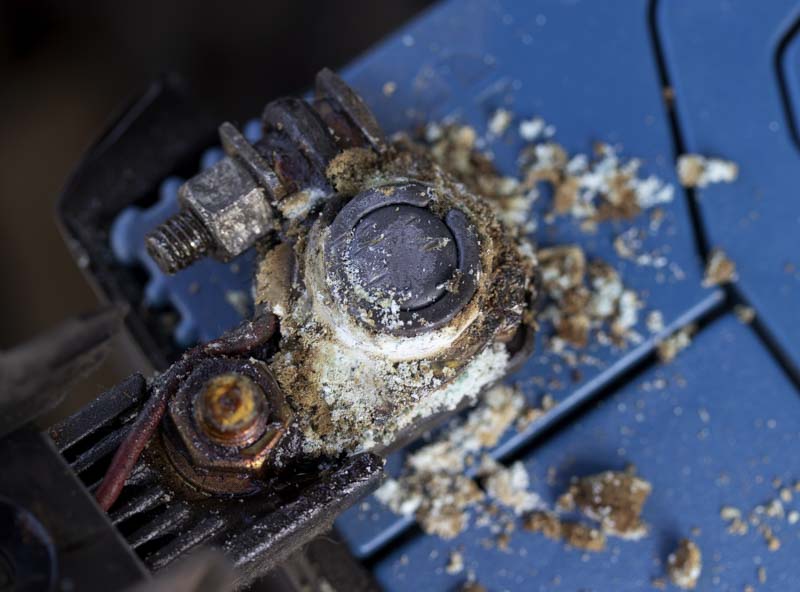
Battery corrosion usually occurs on the negative terminal. Over time, if you frequently go for short drives where you use a lot of accessories that draw power from the battery, your alternator doesn’t have time to charge the battery, and the result is corrosion on the negative terminal.
Sometimes the corrosion is on the positive terminal due to overcharging. This usually occurs when you have a bad voltage regulator or drive for long distances without using a lot of accessories.
Importance of Removing Battery Corrosion
Removing battery acid and corrosion is important for several reasons.
Safety Concerns
Corroded batteries are unsafe. Battery corrosion is extremely caustic and can burn your skin or eyes.
Always wear safety glasses and nitrile gloves when you work on a battery because there is a risk of explosion. While it’s not common, all it takes for a battery to explode is the presence of hydrogen and oxygen gases combined with a spark.
There are many different battery types, like lithium-ion. Interested in learning more? Check out our guide to how long lithium-ion batteries last!
Performance and Longevity
Corrosion creates resistance between the battery and the other components in your vehicle, such as your starter motor, fuse panel, and alternator. This resistance reduces the amount of available power to components and impacts their performance and longevity.
Battery corrosion also eats away at metals, causing them to become weakened. Corrosion at your battery’s posts can work its way up into the wires of the cables, creating more resistance and weakening the wires. Eventually, it can cause them to fray and break.
The corrosion also eats away at the metal on the terminals, and they may need replacing. In older cars, you can replace the terminal ends on your battery cable with a universal cable, but it’s not recommended on newer vehicles. Universal terminals don’t provide enough power to the components and computer systems that newer vehicles require to operate.
Any time you have corrosion, there’s resistance in the connection. Newer vehicles have many special components and computers that draw power from the battery for sensors, and the resistance will impact your vehicle’s performance.
Benefits of Cleaning Batteries
Corroded batteries are hard on the components of electrical systems, and they can reduce the lifespan of motors, tools, and gadgets. When it comes to your vehicle, regular maintenance of your car battery will ensure you never get stranded with a dead battery.
Learn more about the benefits of corroded battery cleaning.
Improved Electrical Connectivity
Corrosion increases resistance, which reduces the amount of power that can flow through a wire or cable. By removing corrosion, you will improve the electrical connectivity. For example, you may immediately notice that your vehicle’s engine cranks better or that your headlights are brighter after you clean battery corrosion.
Cost Savings
In addition to ensuring optimal performance, regular battery maintenance prolongs its lifespan. Taking proactive measures to keep your battery in top condition prevents expensive breakdowns and reduces the need for replacement.
Tips for Cleaning Battery Corrosion
Follow these tips for cleaning the battery corrosion in your vehicle. You can use a similar process for home electronics and gadgets like flashlights and remote controls.
Gathering Necessary Tools and Materials
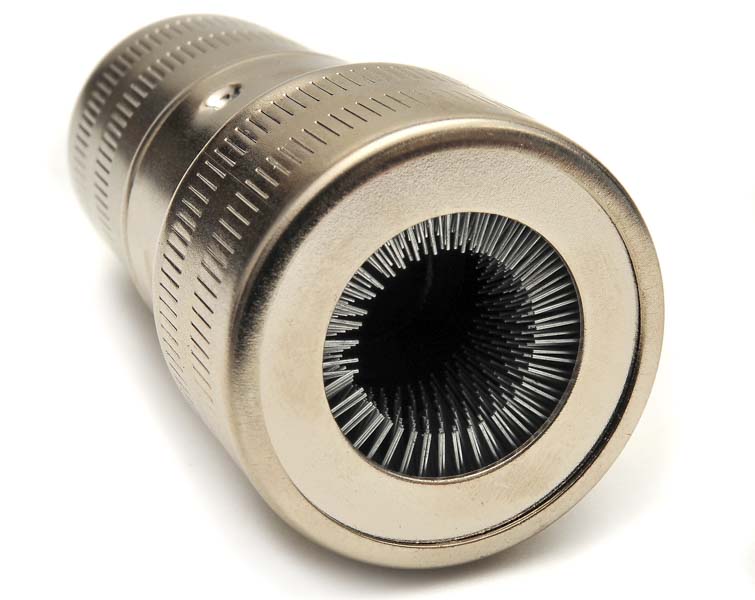

Here are the supplies you’ll need to clean corrosion from battery terminals.
- Cleaning solution
- Wire brush
- Nylon brush (an old toothbrush will work)
- Rags
- Nitrile gloves
- Safety glasses
- Battery memory saver
The best way to clean battery terminals is to remove the battery and work on it outdoors or with the garage door open. Place a fan to blow across the work area pointed away from you.
Professional Corrosion Cleaning Tools
The following products help clean corroded batteries:


DIY Cleaning Solution for Small Appliances and Tools
Make a cleaning solution from one cup of warm water and one tablespoon of baking soda to clean small batteries for your electronics and power tools. Use a cotton swab to apply the solution to the corroded parts.
DIY Cleaning Solution for Car Batteries
Make a battery terminal cleaner with baking soda for your car battery using 1/4 cup hot water and 4 tablespoons of baking soda. Apply the thick paste with an old toothbrush.
Remove the Battery
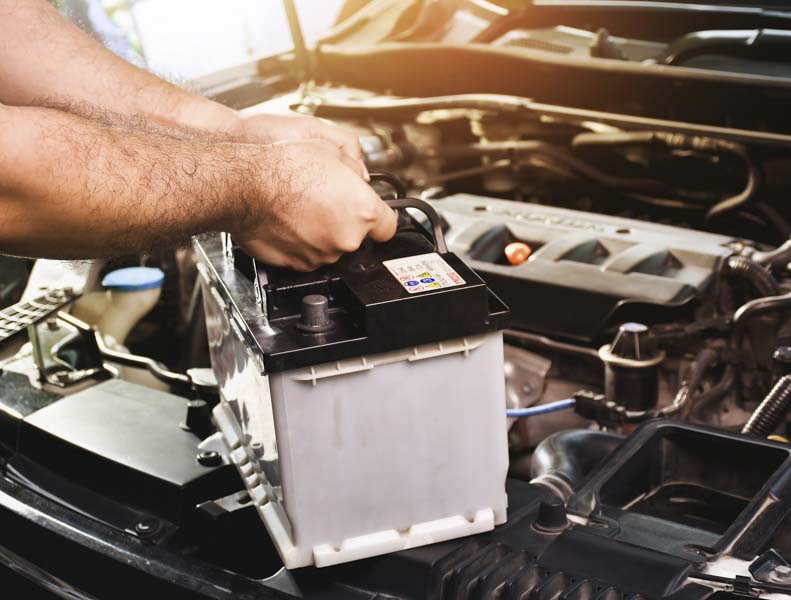

No matter what type of equipment you’re working on, the best way to clean battery corrosion starts with removing the battery. This method makes it easier to completely clean the entire battery surface without impacting the components and cables.
Also, with car batteries, if the cleaning solution makes its way into the cells through the vent caps on top, it can neutralize the cells and destroy your battery.
To remove your car battery, start by connecting a battery memory saver. It will provide surge protection and help your vehicle’s computers save important information.
Then, remove the negative battery terminal, followed by the removal of the positive terminal. After disconnecting the terminals, remove the bracket and pull out the battery.
Step-by-Step Cleaning Process
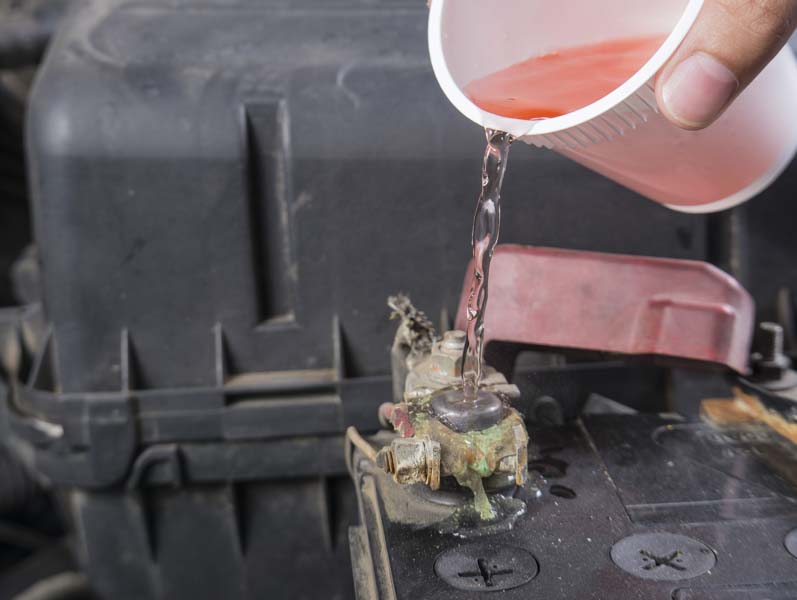

Follow these steps to clean your corroded battery:
- If you can, remove battery corrosion before applying the cleaner.
- Apply the baking soda paste to the terminals, posts, and cables, allowing it to sit for 5 to 10 minutes to neutralize the battery corrosion.
- Use an old toothbrush or battery terminal brush to thoroughly clean the posts and terminal ends.
- Avoid getting any of the baking soda solution near the vent caps.
- Apply more baking soda and water to neutralize any remaining corrosion.
- Moisten a rag with water and wipe the battery completely clean.
Preventative Measures
Dielectric grease or a battery terminal protector spray will help prevent battery corrosion. Once you remove corrosion from your car battery, you can use one of these products to reduce the possibility of further corrosion.
Removing Battery Corrosion from Car Batteries
When removing battery corrosion from car batteries, always prioritize your safety by wearing safety glasses and nitrile gloves. Remove your gloves before wiping your face or touching other objects.
If you have problems with corrosion on your car battery, you may also see it on the cables near the starter. Look for signs of corrosion, which makes the wires turn green.
Whenever you can see corrosion on the outside of cables, it’s likely on the inside of the wire, causing resistance and weak starting cranks. Eventually, the corrosion can impact the performance and longevity of the starter motor or cause the cable to fry and break.
When to Clean Batteries
Now that you know how to clean corrosion off your battery, when should you do it? Learn how to recognize the signs of battery corrosion and recommendations for scheduled battery maintenance.
Signs of Battery Corrosion
In most cases, battery corrosion is obvious. Here are the signs to look for.
Visible Buildup
The visible buildup of battery corrosion is typically seen on the terminals. Most commonly, it occurs on the left terminal due to undercharging your battery. Battery corrosion occurs in various colors, depending on the chemical reaction. It’s usually white, brown, or blue-green.
You may also notice visible buildup on the battery cables, brackets, and the surface of the battery around the vents. Often, the leaked battery acid on the surface leads to increased resistance, which disrupts the current and impacts the life of your battery.
Bad Smell
Failing batteries will sometimes smell bad due to the sulfuric acid. When it breaks down, it emits a terrible smell like rotten eggs. If the corrosion isn’t addressed, it can compromise your battery’s integrity and lead to premature failure.
Leaks
Leaks often accompany battery corrosion. A leaking battery is usually caused by overcharging. When the electrolytes in the cells get overcharged, the battery boils, which leads to leaking. Bulging batteries is another symptom caused by the same issue.
Decreased Voltage
Since battery corrosion increases resistance, you may notice a decrease in power. In your car, this can mean that headlights aren’t as bright or your engine doesn’t start easily.
Age of Battery
If your battery is old, it might be time to replace it. The average lifespan of a car battery is about five to seven years, but you can get high-quality batteries that last up to 10 years.
How long your battery lasts depends on the quality of the battery and the conditions under which it’s stored. For example, if you live in a hot climate, it can compromise the life of your battery.
Maintenance Schedule
Proper car battery maintenance can keep you from being stranded or having to replace your battery too soon.
| Maintenance step | Task | How often |
| Visual Inspection | – Check for corrosion on cables and terminals – Check for a secure connection – Inspect for leaks and signs of physical damage |
Monthly |
| Cleanliness | – Clean terminals and posts with a wire brush – Remove dirt and debris from the battery case |
Annually |
| Fluid level | – Check electrolyte levels (if the battery has removable caps) – Add distilled water as needed |
Every six months |
| Testing the charge | Use a multimeter to test the battery voltage | Every three to six months |
| Mounting | Check to ensure the battery is mounted securely | Annually |
| Age | Check the battery age to determine if it needs to be replaced | Annually |
Additional Considerations When Cleaning Battery Corrosion
Here are a few additional factors to consider when you’re cleaning batteries.
Battery Types
There are many different types of batteries and cases. It’s important to follow manufacturer guidelines when cleaning batteries.
Many homeowners use lithium-iron phosphate batteries for solar systems and backup power. While they also need maintenance, they’re less likely to corrode than lead-acid batteries.
Avoid working on batteries in electric vehicles, as they have high voltage and can be dangerous.
Environmental Considerations
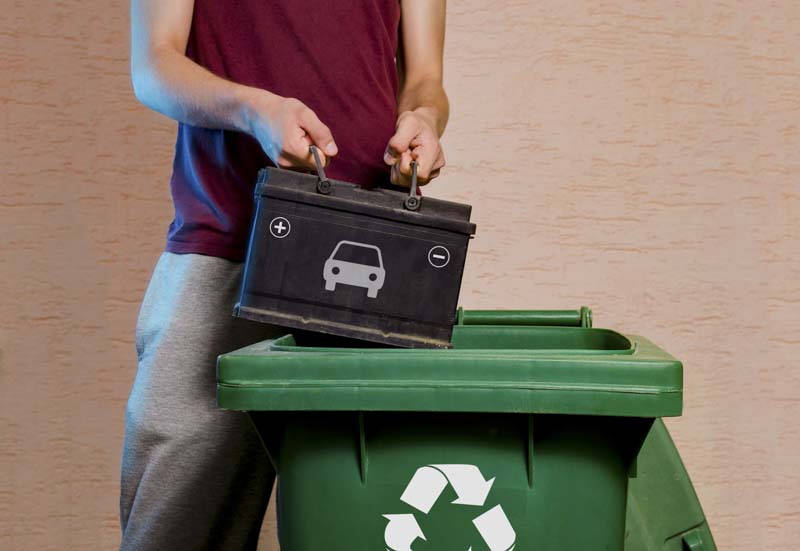

When you’re cleaning battery corrosion, be mindful of the environment. Letting corrosion spill onto the ground can harm the ecosystem and wildlife. Always dispose of batteries per local regulations for hazardous waste.
FAQs about How to Clean Battery Corrosion
What causes battery corrosion?
When the sulfuric acid in batteries comes into contact with metal terminals, corrosion occurs. Usually, the sulfuric acid stays in the cells of the battery, but in some situations, it will escape and come in contact with the posts and terminals. This is usually caused by one of the following issues:
- Escaping gas coming out of vent caps,
- Adding too much water, if your battery has refillable cells,
- Overcharging,
- Undercharging, or
- Your battery is old.
Can I clean battery corrosion at home?
You don’t need a mechanic to clean the corrosion on your battery. You can clean battery corrosion from the terminals and cables with the right tools and supplies. Be sure to follow safety recommendations.
Is it safe to touch corroded batteries?
The corrosion on battery terminals is very caustic, and touching it can eat away at your skin. Use safety glasses and nitrile gloves when working on a battery. Remove the gloves before you touch anything or wipe your face.
How often should I clean my batteries?
You should inspect and clean corroded battery terminals once or twice a year. In addition, monthly visual inspections will help you catch problems sooner.
Can I prevent battery corrosion entirely?
Once you get your battery terminals, posts, and cables completely clean, you may be able to apply dielectric grease or a spray protectant to prevent corrosion from recurring. However, if your battery is near the end of its lifespan or has another problem, like a bad alternator, you could end up with more corrosion.





